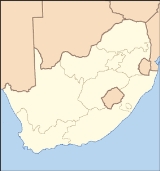
Hoedjiespunt
Encyclopedia
Hoedjiespunt is a Middle Pleistocene
aged hominid fossil-bearing site on the West coast of South Africa
, near the town of Saldanha Bay
. The site is an ancient Brown Hyena
lair dug into the side of a sand dune, located on a peninsula overlooking the Atlantic Ocean
. The site became fossilized under a large calcrete formation around 280,000 years ago, at which time it was likely several kilometers from the ocean.
shaft from a juvenile hominid attributed to Homo heidelbergensis
. However, Stynder et al. (2001) suggest that the evidence from the mandibular incisors from HDP1 is "insufficient to point to closer affinities of the HDP1 sample with either African or European Middle Pleistocene Hominids."
Middle Pleistocene
The Middle Pleistocene, more specifically referred to as the Ionian stage, is a period of geologic time from ca. 781 to 126 thousand years ago....
aged hominid fossil-bearing site on the West coast of South Africa
South Africa
The Republic of South Africa is a country in southern Africa. Located at the southern tip of Africa, it is divided into nine provinces, with of coastline on the Atlantic and Indian oceans...
, near the town of Saldanha Bay
Saldanha Bay
Saldanha Bay is a natural harbour on the south-western coast of South Africa, north west of Cape Town. The town that developed on the northern shore of the bay, also called Saldanha, was incorporated with five other towns into the Saldanha Bay Local Municipality in 2000. The current population of...
. The site is an ancient Brown Hyena
Brown Hyena
The brown hyena is a species of hyena which occurs in Namibia, Botswana, western and southern Zimbabwe, southern Mozambique and South Africa. It is currently the rarest hyena.-Description:...
lair dug into the side of a sand dune, located on a peninsula overlooking the Atlantic Ocean
Atlantic Ocean
The Atlantic Ocean is the second-largest of the world's oceanic divisions. With a total area of about , it covers approximately 20% of the Earth's surface and about 26% of its water surface area...
. The site became fossilized under a large calcrete formation around 280,000 years ago, at which time it was likely several kilometers from the ocean.
Fossil discovery
Prior to the early 1990s, Hoedjiespunt had been known for several years as a fossil locality after roadworks had exposed abundant bone when a grader dug into a fossilized sand dune. A number of very fragile fossils were subsequently recovered in the initial search. In 1993, a single fossil hominid tooth was found in fragments eroding from the surface of the deposit, prompting further excavations which recovered many thousands of fossils, among them teeth, skull fragments and a tibiaTibia
The tibia , shinbone, or shankbone is the larger and stronger of the two bones in the leg below the knee in vertebrates , and connects the knee with the ankle bones....
shaft from a juvenile hominid attributed to Homo heidelbergensis
Homo heidelbergensis
Homo heidelbergensis is an extinct species of the genus Homo which may be the direct ancestor of both Homo neanderthalensis in Europe and Homo sapiens. The best evidence found for these hominins date between 600,000 and 400,000 years ago. H...
. However, Stynder et al. (2001) suggest that the evidence from the mandibular incisors from HDP1 is "insufficient to point to closer affinities of the HDP1 sample with either African or European Middle Pleistocene Hominids."

